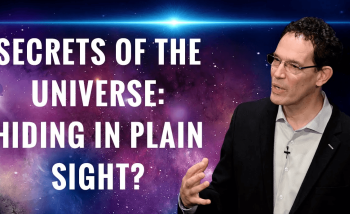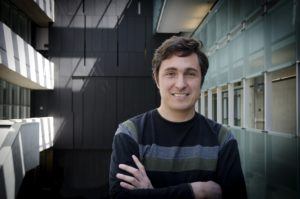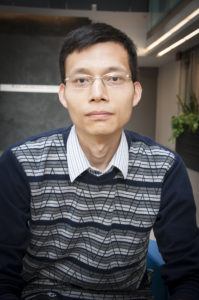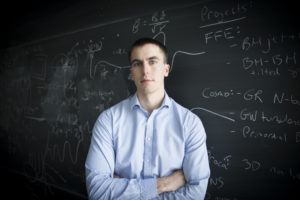Since its arrival two years ago, gravitational wave multimessenger astronomy has treated physicists to a smorgasbord of tantalizing observational data. We’ve watched black hole mergers, linked gamma ray bursts to neutron star collisions, and seen gold created through cosmic cataclysms.
Yet the bounty has created more questions than it has answered. Which, for scientists, is just perfect. There are few things in science more delectable than an open question. An open question within reach of an answer? Well, that’s downright irresistible.
What is the interior of a neutron star like, and what can that tell us about nuclear physics? Can we use black holes as massive particle colliders? What is dark matter? How are black holes born?
The answers, it seems, might be found by considering black holes not just as something to be studied, but as a tool to be harnessed.
It’s a new approach that has been a century in the making. The two key pillars of modern physics – the theory of general relativity and quantum mechanics – were developed in the early 20th century. While each theory has been shown to be exquisitely accurate in its respective realm, neither works with the other.
The quest to unite them took an unexpected turn in 1974, when cosmologist Stephen Hawking realized that, thanks to quantum effects, black holes emit black body radiation. Suddenly, black holes became a key part of the effort to unite quantum mechanics and gravity.
Now, thanks to the arrival of multimessenger astronomy – which uses multiple telescopes and observatories to record the same astrophysical event using gravitational waves and different wavelengths of light – scientists are revealing deep truths about the universe at a (relatively) breakneck pace.
So far, astrophysics has been the immediate winner. But big benefits are also expected for nuclear physics (thanks to the ability to probe the inner workings of high-density stars), early universe cosmology (third-generation detectors could see all – yes, all – black hole collisions in history), and particle physics (where theorists are proposing creative theories to obtain information about dark matter).
This mix of theory and experiment is enough to throw physicists into a veritable feeding frenzy. Or it would be, if the work wasn’t quite so exacting, methodical, and very, very deliberate.
It’s all in the timing
When Luis Lehner was an undergrad student in Argentina in the 1990s, he assumed that his decision to specialize in general relativity would be an on-ramp to physics’ slow lane. Back then, any experimental application for this work was more than 20 years away; for many of his peers, that was too long a wait.
Perimeter Institute Faculty Chair Luis Lehner.[/caption]
In grad school, he decided to specialize in numerical relativity. This sub-branch of general relativity uses simulations to work out how gravity behaves in extreme situations.
Fast forward two decades and the pace is anything but slow. It turns out those extreme regions are extremely versatile, scientifically.
On the experimental side, the Laser Interferometer Gravitational-Wave Observatory (LIGO), the Canadian Hydrogen Intensity Mapping Experiment (CHIME), the Event Horizon Telescope, and other experiments mean things that were theorized or presented as observational puzzles – gravitational waves, fast radio bursts, and the shadow of a black hole – are now logged in data records.
Meanwhile, theoretical physicists are pushing deeper into uncharted territory by linking specialties that were once deemed separate. Cosmology and astrophysics now overlap with particle physics, quantum field theory, and more.
The result for Lehner is that he has become a leading figure in one of science’s fastest developing fields, his work split between the immediate and the eventual: he helps decipher the observational data streaming in from today’s experiments, while developing predictions to be pursued by experiments decades, or even generations, from now.
“I know how long it takes to come up with the models that will be used in the future,” says Lehner, who is Faculty Chair at Perimeter Institute and the theorist-in-residence for the Gravitational Wave International Committee. “I’m anxious today for an answer I know will be needed 20 years from now. If we don’t start today, we might miss that boat. Important opportunities could slip by.”
There are big questions on the menu: Are primordial black holes the seeds of today’s supermassive black holes? Why do the black hole mergers we’ve detected involve objects with low spin or randomly oriented spins? Where does our theory of gravity break down – and what will replace it?
Unsurprisingly, young researchers are scrambling to get a seat at the table. Lehner is there to welcome them with open arms. After all, the challenges ahead are too big for one specialty.
“These are fields that have advanced for a long time independently. Now we have a multitude of messengers from different sources that require expertise in all of them,” says Lehner.
“Coming together in a multidisciplinary way is crucial, not only to address some of the challenges but also to bring in the next generation of people who can talk more than one language on this front.”
The field is setting a demanding pace. The Advanced LIGO and VIRGO gravitational wave detectors are running, and it is hoped the Kamioka Gravitational Wave Detector (KAGRA) in Japan will come online later this year. In a decade or so, the space-based gravitational wave telescope LISA will be launched. By that time, the third generation of Earth-based detectors should almost be ready.
“There will be this passing of the baton, where we’re running this relay in which every new runner – every new experiment – is going to be much faster and much stronger than the previous one,” Lehner says. “Eventually, we’re going to be able to probe much more deeply both individual events and multiple events.”
The success of gravitational wave detectors has reinvigorated a field that, just a few decades ago, looked relegated to theory for theory’s sake. And this, says Lehner, is just the beginning.
“There’s a larger front here at Perimeter where people are looking at common ground in creative or unexplored corners. If they pan out, there will be a really high pay-off.”
Superradiance and the hunt for axions
Hawking radiation showed that black holes could be used as particle accelerators. Perimeter Institute particle physicist Asimina Arvanitaki is working out ways to put that idea into practice.
In a paper published in 2010, Arvanitaki and collaborators including Sergei Dubovsky outlined how black holes could be used to detect a hypothetical particle called the axion, thought to be a candidate for dark matter. The idea centres on a process called superradiance.
Perimeter Institute Faculty member Asimina Arvanitaki.[/caption]
Superradiance is a feedback loop consisting of two ingredients: a rotating black hole and a boson particle that is ultralight and has a Compton wavelength as big as the black hole. (Yes, such a thing may exist.)
It all starts if – or when – a black hole spontaneously emits this boson. Thanks to its wavelength matching the size of the black hole, the particle absorbs some of the black hole’s rotational energy. This is the start of stimulated emission, explains Arvanitaki, where the black hole keeps making more and more of these particular bosons.
Because bosons can occupy the same quantum state, a cloud of particles forms around the black hole. The bigger the cloud, the more energy it can siphon from the black hole, which makes the cloud even bigger.
But the phenomenon has an inherent instability: the loss of energy slows down the black hole’s rotation. When the black hole’s rotational frequency drops enough to match the oscillation frequency of the cloud, the instability no longer holds and the phenomenon shuts off.
While the notion of superradiance was first put forward in the 1960s, it was Arvanitaki and Dubovsky who extended the idea and proposed that the bosons in superradiance could be a candidate for axions. (That paper now has more than 500 citations.)
Should such a particle exist, it is a promising candidate for dark matter.
“It sounds like something out of science fiction books. It looks like an atom in the sky and it does all sorts of weird things,” says Arvanitaki, who holds the Stavros Niarchos Foundation Aristarchus Chair at Perimeter Institute.
“The great thing about this is it’s actually embedded in the theory of general relativity. There is no magic that needs to happen. The particle doesn’t even need to be cosmologically abundant; if it exists in the fundamental theory, then the black hole will take care of the rest.
“These are the best type of ideas – the ones where you say, ‘Why didn’t people think about this 40 years ago?’”
Thanks to multimessenger astronomy, the hunt for axions is within reach – and it’s gaining interest. When Perimeter Institute held a superradiance workshop in 2018, more than 30 theorists and experimentalists came from around the world to explore possible collaborations. Some participants were experimentalists from LIGO.
The gravitational wave detectors can already detect “monochromatic” gravitational waves (waves of a single wavelength), which are the kind that would come from superradiance. However, LIGO’s data analysis must be modified to seek the “fingerprint” of superradiance: unlike the decreasing frequencies of neutron star spins, the properties of a superradiance signal would drift up and grow with time.
So now, Arvanitaki and others are talking with experimentalists to find ways to incorporate the axion search criteria into current facilities.
“The tools are there, they just need to tweak them in a way to be more targeted to this idea,” says Arvanitaki. “The question is, how do you optimize those tools to look for this?”
While the idea is well motivated, Arvanitaki notes that there is no way to guarantee we’ll discover it. “It’s a high risk, high reward game,” notes Arvanitaki. “Most of the time you’ll fail, but the one time that you will succeed is going to be groundbreaking, because we’ll be discovering something completely new about the world as we know it.”
Beyond black holes
Black holes aren’t the only massive and mysterious objects in our universe that can serve as tools. Many scientists find another object just as intriguing, and it comes with a huge benefit: you can actually see it.
Neutron stars are the remnants of collapsed massive stars. These objects are ultradense – their cores compressed to the density of atomic nuclei – and have extremely strong gravitational fields.
That makes them particularly interesting for physicists like Huan Yang. The general relativity specialist has had a front row seat in the rise of multimessenger astronomy, collaborating with experimentalists at LIGO to perform instrumental noise analysis before earning his PhD at Caltech in 2013.
Perimeter Associate Faculty member Huan Yang.[/caption]
“The neutron star collisions are the giant colliders of our universe,” says Yang, who is now a faculty member at the University of Guelph and associate faculty at Perimeter.
“At the starting point, everybody was trying to figure out how to observe these kinds of things. Now the focus of the area has shifted to how do we learn physics from these events. It gives us data that we cannot obtain from our Earth-bound experiments.”
There’s a slight problem, though: we actually know very little about neutron stars and virtually nothing about their inner workings, because we don’t know the neutron star equation of state.
Equations of state detail how an elastic material gets deformed by pressure. For a neutron star, the equation of state will outline how gravity compresses and deforms the star, and through that scientists can work out the star’s radius and inner structure.
“We have some [neutron star] models when the density is not very high, but deep in the star, the density is really high and basically all our models fail,” Yang says. “By detecting these events we will learn nuclear physics.”
To get that information, we need to get a clearer view of neutron star mergers. Thankfully, Yang and collaborators like Perimeter Faculty member William East are working on that, too.
Gaps left to fill
Like Lehner, William East uses numerical relativity to understand strong gravity. He co-organized the superradiance conference with Arvanitaki and has worked with Lehner and Yang to study neutron star mergers, black hole magnetospheres, and ways to distinguish between low-mass black hole mergers and neutron star mergers.
His goal is as simple as it is bold: “I just want to understand all of the interesting phenomena that happen in this new regime that we’re just beginning to glimpse.”
Neutron star mergers are a perfect example of the gaps left to fill. Today’s detectors can pick up the gravitational waves that are flung out just before a merger; telescopes and radio telescopes can record the electromagnetic radiation issued after a merger. But the point of cataclysm? Well, we just can’t see it yet.
“At the most violent and exciting part, when the [neutron] stars start to smash together, that’s when the frequency becomes too high for LIGO to see the gravitational waves,” East explains.
“There’s a lot of interesting science you could do if you could actually detect that merger and post-merger. These stars smash into each other and we don’t know: Did they immediately form a black hole? Do they form this very hot, perturbed star that’s oscillating at high frequencies? We don’t really know at all.”
Perimeter Institute Faculty member Will East.[/caption]
How these objects end up on a collision course is also something of a mystery. While the mergers we’ve seen so far involve objects that spin toward each other in a shrinking circular orbit, East wants to know if a different kind of merger exists: “eccentric” mergers of objects whose orbital paths look more like overlapping ovals.
For these systems, the gravitational wave signal would look like a burst every time the objects had a close encounter. “This [gravitational wave burst] would be the smoking gun that you have this other class of binaries that were formed in this different way,” he says.
What’s so interesting about eccentric mergers? They could show how some pairs end up bound to each other, which could provide clues about the environment each object came from.
The spin of neutron stars could also give some indication of how these binaries form. The binary neutron stars that we’ve seen in our own galaxy – pairs that won’t merge for a very long time – do have low spins, and the one merger of neutron stars that we’ve observed through multimessenger astronomy was also consistent with low-spin stars.
But the data from that merger did not rule out the possibility that the merging stars had significant spin. How would a rapidly spinning neutron star change the merger dynamic? To know that, we again need to see the moment of impact.
East isn’t impatient, though. As he points out, a few years ago we’d seen nothing. Some of these questions could be answered within years; others will take decades or longer. Balancing the two is part of the appeal of multimessenger astronomy – as is the very real likelihood that fresh mysteries are just around the corner.
“I think the really exciting possibility is that there will be some surprises, things we weren’t expecting,” says East. “Since this is a completely new way of looking into the universe, I think it would be weird if we already anticipated everything that is out there.”
Further exploration
About PI
Perimeter Institute is the world’s largest research hub devoted to theoretical physics. The independent Institute was founded in 1999 to foster breakthroughs in the fundamental understanding of our universe, from the smallest particles to the entire cosmos. Research at Perimeter is motivated by the understanding that fundamental science advances human knowledge and catalyzes innovation, and that today’s theoretical physics is tomorrow’s technology. Located in the Region of Waterloo, the not-for-profit Institute is a unique public-private endeavour, including the Governments of Ontario and Canada, that enables cutting-edge research, trains the next generation of scientific pioneers, and shares the power of physics through award-winning educational outreach and public engagement.
You might be interested in


Spiralling light from M87’s supermassive black hole reveals strong magnetic fields
November 8, 2023




